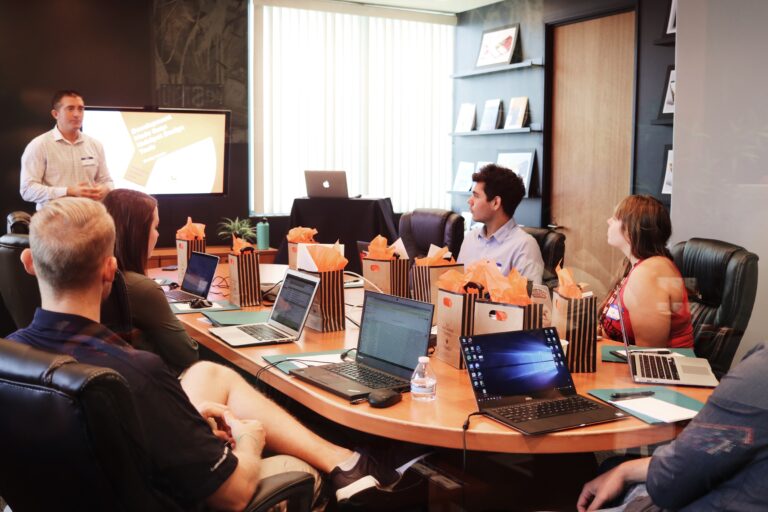Inspiring Innovation
How Leaders Foster a Culture of Creative Problem-Solving
In today’s fast-paced and ever-evolving business landscape, leaders face the challenge of inspiring innovation and fostering a creative problem-solving culture. But fear not, for there are strategies that can help them navigate these waters!
By creating space for creativity, rewarding ideas, and empowering teams, leaders can set the stage for a collaborative and forward-thinking environment. Testing and validation, emphasizing diverse perspectives, and cross-pollination of ideas are also vital.
So, let’s dive in and explore how leaders can inspire innovation and create a culture that nurtures creativity and innovative thinking.
Creating Space for Ideation
Leaders give employees dedicated time for brainstorming and idea generation. They establish regular sessions for out-of-the-box thinking and encourage personal reflection and problem-solving time. They understand that to foster a culture of creative problem-solving, it is crucial to provide space for creativity. To facilitate this process, leaders employ various brainstorming techniques and idea-generation strategies.
They create an environment where employees feel empowered to share their thoughts and explore new possibilities. By setting aside specific time for brainstorming and encouraging personal reflection, leaders ensure that innovative ideas are given the attention they deserve. These sessions allow for the free flow of ideas and promote collaboration among team members.
Rewarding Ideas and Problem Identification
Employees are motivated to generate ideas and identify problems through a reward system implemented by their organization. This recognition and incentivization of innovation is crucial in fostering a creative problem-solving culture.
Here are three ways organizations can effectively reward ideas and problem identification:
-
Recognizing contributions: Leaders understand the importance of acknowledging and appreciating the efforts of employees who generate valuable ideas. They provide financial or verbal recognition to encourage a sense of pride and ownership in their contributions.
-
Incentivizing innovation: Organizations implement rewards that provide tangible incentives for employees who consistently develop innovative ideas. This could include bonuses, promotions, or other forms of recognition that demonstrate the organization’s commitment to fostering innovation.
-
Cultivating a culture of creativity: Leaders create an environment where employees feel empowered to share their ideas and are encouraged to think outside the box. This includes providing opportunities for brainstorming sessions, fostering collaboration, and supporting risk-taking.
Setting Clear Goals
By establishing clear goals, organizations provide a sense of direction and purpose, driving their teams towards effective ideation and solution finding.
Goal alignment is crucial in motivating employees to work towards a common objective. When leaders communicate clear goals, it helps employees understand the problem or opportunity that requires creativity and solution-finding. This clarity creates a sense of urgency and drive behind the goal, motivating teams to take action.
By applying pressure and fostering momentum, leaders ensure efficiency and progress toward finding solutions. Clear goals also communicate the importance of the task, instilling a sense of purpose and determination in the team members.
Ultimately, by setting clear goals, leaders drive motivation and inspire their teams to engage in the ideation process and find innovative solutions actively.
Empowering Teams to Find Solutions
Encouraging autonomy and ownership, leaders empower teams to seek and discover solutions on their own actively. By fostering a culture of team ownership, leaders enable their employees to take responsibility for finding innovative solutions to challenges. This approach promotes creative exploration and encourages employees to think outside the box.
Through a collaborative and forward-thinking approach, leaders create an environment where teams are empowered to think creatively and explore possibilities. This includes providing employees with the necessary resources and support to tackle problems and overcome challenges.
Testing and Validation
Leaders continuously measure and refine new ideas through testing and validation techniques. They understand the importance of measuring success to determine the viability of an idea. They can gather data and insights to refine their ideas and make informed decisions by implementing testing methods.
These leaders prioritize learning and success over failure, recognizing that testing is crucial for innovation. Through a series of validation techniques, such as surveys, prototypes, and market research, they ensure their ideas are aligned with customer needs and preferences.
Emphasizing Collaboration and Diverse Perspectives
CLeaders value collaboration and diverse perspectives as they recognize that valuable ideas can come from anyone in the organization. Leaders foster a culture of creative problem-solving by promoting inclusivity and encouraging teamwork. They understand that innovative solutions can be found when individuals from different backgrounds and experiences come together.
To emphasize collaboration and diverse perspectives, leaders take the following actions:
- They create a safe and inclusive environment where everyone’s voice is heard and respected.
- They actively encourage employees to share their ideas and opinions, regardless of their position or role.
- They facilitate cross-functional collaboration and create opportunities for teams to collaborate on projects.
Customer Focus
Leaders actively gather and analyze customer data to prioritize customer satisfaction and anticipate future demands. Leaders can align their innovation efforts with customer expectations using customer feedback and understanding customer needs.
They recognize the importance of customer satisfaction for business success and continuously monitor customer interactions, sales, and retention. Using data, leaders can anticipate future customer demands and align their strategies accordingly.
This customer focus allows leaders to tailor their products and services to meet their customers’ evolving needs and preferences. They understand that by actively listening to and understanding their customers, they can stay ahead of their competitors and drive innovation that genuinely resonates with their target audience.
This collaborative and forward-thinking approach ensures customer satisfaction remains at the forefront of their business strategies.
Future-Oriented Thinking
Emphasizing the importance of forward-thinking, leaders consistently encourage their teams to anticipate industry and company changes. They use contextual knowledge, market trends, and projections to envision the future. By embracing futuristic strategies and predicting trends, leaders foster a culture of innovation and creative problem-solving.
They inspire their teams to think beyond the present and envision potential future scenarios. This forward-thinking approach allows organizations to stay ahead of the competition and adapt to changing market conditions. Leaders provide tools and resources to support their teams in exploring new ideas and technologies that may shape the future.
They encourage collaboration and the cross-pollination of ideas to generate innovative solutions. By instilling a future-oriented mindset, leaders empower their teams to proactively identify opportunities and challenges, driving growth and success for the organization.
Cross-Pollination of Ideas
Encouraging employees to explore ideas from different teams and industries, leaders promote a diverse and inclusive environment that fosters the cross-pollination of innovative solutions. This approach brings several benefits to the organization.
By sharing knowledge and experiences from various areas, teams can gain fresh perspectives and insights that lead to breakthrough ideas. It also promotes collaboration and creates opportunities for learning from different approaches and methodologies.
Furthermore, cross-pollination of ideas enables employees to think outside their immediate work scope, encouraging creativity and out-of-the-box thinking. This knowledge-sharing enhances problem-solving capabilities and cultivates a culture of innovation.
Ultimately, by valuing diverse perspectives and encouraging the exchange of ideas, leaders create an environment that drives continuous improvement and paves the way for future success.







